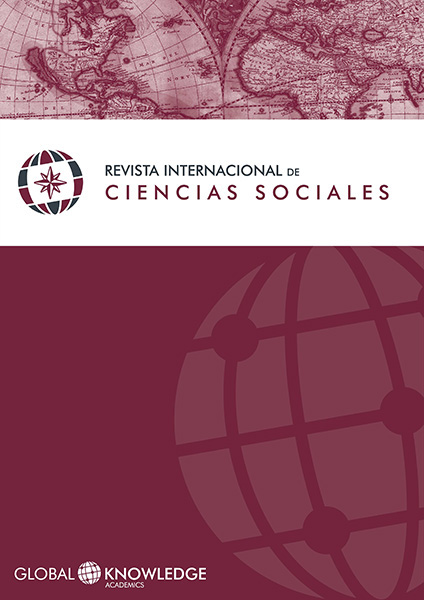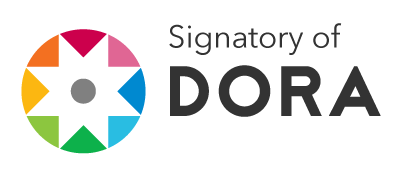The Role of PGE in the Financial Performance of Entrepreneurial Microenterprises for Regional Socioeconomic Development
DOI:
https://doi.org/10.37467/gka-revsocial.v8.2028Keywords:
Entrepreneurship, Financial performance, Microenterprise, Social and economic development, economía personalAbstract
Purpose. To know the degree of influence exercised by business management practices on the financial performance of entrepreneurial microenterprises for regional socio-economic development. Methodology: The methodological design used was quantitative, explanatory, observational and transversal. 127 young entrepreneurs from the state of Guanajuato, Mexico were analyzed. An SEM model was developed whose goodness and fit indices (X2 = 172.386 df = 101; CFI = 0.942 and TLI = 0.932; RMSEA = .07) are acceptable. Results: A positive and significant relationship was found between the business management practices and the financial performance of entrepreneurial microenterprises. Likewise, business management practices have a positive and significant influence on the financial performance of entrepreneurial microenterprises in the state of Guanajuato, Mexico.
Downloads
Global Statistics ℹ️
|
482
Views
|
180
Downloads
|
|
662
Total
|
|
References
Ahire, S., Golhar, D., & Waller, M. (1996). Development and Validation of TQM Implementation Construct. . Decision Sciences., 27(1). Pp. 23-56. Doi: 10.1111/j.1540-5915.1996.tb00842.x. DOI: https://doi.org/10.1111/j.1540-5915.1996.tb00842.x
Antonakis, J., Avolio, B., & Sivasubramaniam, N. (2003). . Context and leadership: An examination of the nine factor full range leadership theory using the Multifactor Leadership Questionnaire. Leadership Quarterly, 14, 261–295. doi:10.1016/S1048-9843(03)00030-. DOI: https://doi.org/10.1016/S1048-9843(03)00030-4
Bass, B., & Avolio, B. (2004). Multifactor Leadership Questionnaire. Third Edition Manual and Sampler Set. MindGarden, Inc. .
Bollen, K. (1987). Total, direct and indirect effects in structural equation models. . Sociological Methodology. , 17. pp. 37-69. Doi: 10.2307/271028. DOI: https://doi.org/10.2307/271028
Bollen, K. (1989). Structural equations with latent variables. New York, NYS : John Wiley & Sons. DOI: https://doi.org/10.1002/9781118619179
Bonett, D., & Wright, T. (2000). Simple size requirements for estimating Pearson, Kendall and Sperman correlations. . Psichometrika, 65(1). pp. 23-28. Doi: 10.1007/BF02294183. DOI: https://doi.org/10.1007/BF02294183
Carter, N., Gartner, W., & Reynolds, P. (1996). Exploring start-up event sequences. Journal of Business Venturing,, 11, pp.151–166. Doi: 10.1016/0883-9026(95)00129-8. DOI: https://doi.org/10.1016/0883-9026(95)00129-8
Chang, D., & Sun, K. (2007). Exploring the correspondence between total quality management and Peter Senge’s disciplines of a learning organization: a Taiwan perspective. Total Quality Management and Business Excellence, 18 (7), pp. 807–822. Doi: 10.1080/1478. DOI: https://doi.org/10.1080/14783360701349914
Cronbach, L. (1951). Coefficient alpha and internal structure of test. Psycho-metrica, 16. pp. 297 - 335. Doi: 10.1007/BF02310555. DOI: https://doi.org/10.1007/BF02310555
Crosby, P. (1989). Let's Talk Quality: 96 Questions You Always Wanted to Ask Phil Crosby. New York:, USA: Mc Graw-Hill.
Davila, T. (2000). An empirical study on the drivers of management control systems' design in new product development. Accounting. Organizations and Society, 25(4-5), pp. 383-409.Doi: 10.1016/S0361-3682(99)00034-3. DOI: https://doi.org/10.1016/S0361-3682(99)00034-3
De la Garza, M., Zavala, M., & López-Lemus, J. (2016). Competencias del emprendedor y su impacto en el desempeño organizacional. En R. Ojeda, & L. López, Gestión Social Organizaciones Humanas Para Una Sociedad Incluyente. (págs. PP. 7933 - 7956.). Mérida, Yucatán. México.
De Noble, A., Jung, D., & Ehrlich, S. (1999). Entrepreneurial self-efficacy: The development of a measure and its relationship to entrepreneurial actions., . Frontiers of Entrepreneurship Research, Waltham.
Deming, W. (1986). Out of the Crisis. Cambridge, MA.: MIT Press: .
Ebner, A. (2005). Ebner, A. (2005). Entrepreneurship and economic development From classical political economy to economic sociology. . Journal of Economic Studies, 32(3). Pp.256-274. Doi: DOI 10.1108/01443580510611047. DOI: https://doi.org/10.1108/01443580510611047
EFQM. (3 de Octubre de 2016). European Foundation Quality Model . Obtenido de http://www.efqm.org
Fallahi, F., Pouraghi, H., & Rodriguez, G. (2012). The unemployment rate, unemployment volatility, and crime. . International Journal of Social Economics. , 39(6). Pp. 440-448. DOI 10.1108/03068291211224937. DOI: https://doi.org/10.1108/03068291211224937
Flynn, B., Schroeder, R., & Sakakibara, S. (1994). A Framework for Quality Management Research and an Associated Measurement Instrument. Journal of Operations Management, , 11(4), pp. 339-366. Doi:10.1016/S0272-6963(97)90004-8. DOI: https://doi.org/10.1016/S0272-6963(97)90004-8
Hair, j., Hult, G., Rngle, C., & Sarstedt, M. (2014). A primer on partial least squares structural equation modeling (PLS SEM). USA: SAGE Piblications. USA.
Hitt, M. (2001). Iniciativa empresarial estratégica. . SMJ, 22.pp479-491.
Ho, D., Duffy, V., & Shih, H. (1999). An Empirical Analysis of Effective TQM Implementation in the Hong Kong Electronics Manufacturing Industry. . Human Factors and Ergonomics in Manufacturing, 9 (1). Pp.1–25. Doi: 10.1002/(SICI)1520-6564(199924)9:1<1::. DOI: https://doi.org/10.1002/(SICI)1520-6564(199924)9:1<1::AID-HFM1>3.0.CO;2-L
Hoque, Z., & James, W. (2000). Linking balanced score card measures to size market factors: Impact on organizational performance. Journal of Management Research, 12. pp. 1-17. Doi: 10.2308/jmar.2000.12.1.1. DOI: https://doi.org/10.2308/jmar.2000.12.1.1
INEGI. (10 de 08 de 2018). Instituto Nacional de Estadística y Geografía. Obtenido de Empleo y Ocupación.: http://www.beta.inegi.org.mx/temas/empleo/
Jaafreh, A., & Al-abedallat, A. (2013). The Effect of Quality Management Practices on Organizational Performance in Jordan: An Empirical Study. . International Journal of Financial Research., 4(1). Pp.93-109. doi:10.5430/ijfr.v4n1p93. DOI: https://doi.org/10.5430/ijfr.v4n1p93
Jöreskog, K., & Sörbom, D. ( 1981). LISREL: Analysis of linear structural relationships by maximum likelihood and least squares methods. . Chicago, IL. USA: National Educational Resources.
Krumwiede, K., & Charles, S. (2006). Finding the right mix. , . Strategic Finance, 87(10), 37.
Lee, V., Ooi, K., Sohal, A., & Chong, A. (2012). . Structural relationship between TQM practices and learning organisation in Malaysia's manufacturing industry. Production Planning & Control: The Management of Operations, 23:10-11, pp. 885-902, doi: 10.1080/0953. DOI: https://doi.org/10.1080/09537287.2011.642209
Lissitsa, S., & Kol, O. (2016). Generation X vs. Generation Y – A decade of online shopping. Journal of Retailing and Consumer Services. , 31. Pp. 304-312. Doi: 10.1016/j.jretconser.2016.04.015. DOI: https://doi.org/10.1016/j.jretconser.2016.04.015
López, J. (10 de 10 de 2018). El Financiero: Fracasan en México 75% de emprendimientos. Obtenido de http://www.elfinanciero.com.mx: http://www.elfinanciero.com.mx/empresas/fracasan-en-mexico-75-de-emprendimientos
López-de-Alba, P., Zavala, M., De la Garza, M., López-Lemus, J., & Ramos, C. (2016). Causas de fracaso en empresas sociales mexicanas. . The Failure Institute. , pp. 1-29.
López-Lemus, J. (2016). Recursos personales del líder y su influencia con el estilo de liderazgo. . México.: Unpublished PhD. Thesis. Universidad de la Salle, Bajío. .
Martínez, M. (3 de 08 de 2018). El Economista: Proyecta la OIT para México una tasa de desempleo de 3.7% en 2018. Recuperado de:. Obtenido de El Economista: https://www.eleconomista.com.mx/empresas/Proyecta-la-OIT-para-Mexico-una-tasa-de-desempleo-de-3.7-en-2018-20180124-0042.html
McGee, J., Peterson, M., Mueller, S., & Sequeira, J. (2009). Entrepreneurial Self-Efficacy: Refining the Measure. Entrepreneurship theory and Practice, 33(4), 965-988.Doi: 10.1111/j.1540-6520.2009.00304.x. DOI: https://doi.org/10.1111/j.1540-6520.2009.00304.x
Mia, L., & Clarke, B. (1999). Market competition, management accounting systems and business unit performance. . Management Accounting Research. , 10.pp.137-158. Doi: 10.1006/mare.1998.0097. DOI: https://doi.org/10.1006/mare.1998.0097
Millers, D. (1983). The correlates of entrepreneurship in three types of firms. Management Science, 29. pp. 770-791. Doi: 10.1287/mnsc.29.7.770. DOI: https://doi.org/10.1287/mnsc.29.7.770
Moriano, J., Palací, F., & Morales, J. (2006). Adaptación y validación en España de la escala de Autoeficacia Emprendedora, Revista de Psicología Social. . International Journal of Social Psychology, 21:1, pp. 51-64.doi: 10.1174/021347406775322223. DOI: https://doi.org/10.1174/021347406775322223
Muthén, B. (2001). Second-Generation structural equation modeling with a combination of categorical latent variables: New opportunities for latent class/latent growth modeling. En L. Collins, & S. A., New Methods for the Analysis of Change (págs. 289-332). Washington, D.C. DOI: https://doi.org/10.1037/10409-010
Muthén, B. (2002). Beyond SEM: General latent variable modeling. Behaviometrika, 29(1), 81-117. Doi: 10.2333/bhmk.29.81. DOI: https://doi.org/10.2333/bhmk.29.81
Muthén, B., & Muthén, L. (1998-2007). Mplus Version 5.0 statistical analysis with latent variables: User's Guide. Los Angeles, CA. USA: Fourth ed. Muthen & Muthen.
Noordin, R., Zainuddin, Y., Faud, & Mail, R. K. (2015). Performance outcomes of strategic management accounting information usage in Malasia: Insights from electrical and electronics companies. Procedia Economics and Finance, 31. pp. 13-25. Doi: 10.1016/S2212-5671(15)01127-2. DOI: https://doi.org/10.1016/S2212-5671(15)01127-2
OIT. (04 de 12 de 2018). Organización Internacional del Trabajo. Obtenido de https://www.ilo.org/global/lang--es/index.htm
Okoro, J. (2015). Assessment of Management Competencies Possessed by Postgraduate University Business Education Students to Handle Entrepreneurship Business Challenges in Nigeria. . Journal of Education and Practice., 6(18). 129-136.
Ooi, K. (2014). TQM: A facilitator to enhance knowledge management? A structural analysis. . Expert Systems with Applications., 41. Pp. 5167-5179. Doi: 10.1016/j.eswa.2014.03.013. DOI: https://doi.org/10.1016/j.eswa.2014.03.013
Pearson, E. (1929). Some notes on sampling tests with two variables. Biometrika, 21, pp. 337-360. Doi: 10.2307/2332565. DOI: https://doi.org/10.1093/biomet/21.1-4.337
Pearson, E. (1931). The test of significance for the correlation coefficient. Journal of the American Statistical Association, 26. pp. 128-134. Dpi: /10.1080/01621459.1931.10503208. DOI: https://doi.org/10.1080/01621459.1931.10503208
Peng, M. (2012). Global Strategy. . New York. USA: Free Press.
Prajogo, D. (2005). The Comparative Analysis of TQM Practices and Quality Performance Between Manufacturing and Service Firms in Australia. International Journal of Service Industry Management., pp 175-186. Doi: 10.1108/09564230510601378. DOI: https://doi.org/10.1108/09564230510601378
Prajogo, I., & Sohal, S. (2003). The relationship between TQM practices, quality performance, and innovation performance: an empirical examination. International Journal of Quality and Reliability Management, 20 (8). pp. 901-918. Doi:10.1108/02656710310493625. DOI: https://doi.org/10.1108/02656710310493625
Rigdon, E. (1996). CFI versus RMSEA: A comparison of two fit indexes for structural equation modeling, Structural Equation Modeling. . A Multidisciplinary Journa, 3(4), 369-379. Doi: 10.1080/10705519609540052. DOI: https://doi.org/10.1080/10705519609540052
Satorra, A., & Bentler, P. (1994). Correction to test and standar errors in covariance structure analysis. En A. V. Eye, & C. C. (Eds.), Latent Variables Analysis, Applications to Development Research (págs. pp. 399-419). CA: University of California, Los Angeles. USA.: Thousand Oaks.
Schendel, D., & Hoper, C. (1979). Strategic Management. . Boston. USA: Little, Brow.
Schumpeter, J. (1934). The theory of economic development. Cambridge, Massachusetts. USA: Hardvard University Press.
SE. (2016). Diagnóstico 2016 del Fondo Nacional Emprendedor. Ciudad de México. México.: Secretaria de Economía.
SE. (29 de 10 de 2018). Secretaría de Economía. Obtenido de Programa para la Productividad y Competitividad Industrial (PPCI): https://www.gob.mx/se/acciones-y-programas/programa-para-la-productividad-y-competitividad-industrial-ppci
Senge, P. (1992). Building learning organizations. . Journal of Quality and Participation, 15 (2), 30–38.
Shammari, H., & Hussein, R. (2008). Strategic planning in emergent market organizations: empirical investigation. International Journal of Commerce and Management. , 18 (1). pp. 47-59. Doi: 10.1108/10569210810871489. DOI: https://doi.org/10.1108/10569210810871489
Taylor, D. (2007). Entrepreneurship and Small Business (2nd edition) . International Journal of Entrepreneurial Behavior & Research, 13 (3), pp.194-196, https://doi.org/10.1108/13552550710751058. DOI: https://doi.org/10.1108/13552550710751058
Vargas-Hernández, J., Guerra, E., Bojórquez, A., & Bojórquez, F. (2014). Gestión Estratégica de organizaciones. Buenos Aires, Argentina.: Ediciones Insumos Latinoamericanos .
Zahara, S. (1991). Predictors and financial autcomes of corporate etrepreneurship: An exploratory study. Journal of Business Venturing, 6. pp. 259-285 DOI: https://doi.org/10.1016/0883-9026(91)90019-A
Downloads
Published
How to Cite
Issue
Section
License
Those authors who publish in this journal accept the following terms:
-
Authors retain copyright.
-
Authors transfer to the journal the right of first publication. The journal also owns the publishing rights.
-
All published contents are governed by an Attribution-NoDerivatives 4.0 International License.
Access the informative version and legal text of the license. By virtue of this, third parties are allowed to use what is published as long as they mention the authorship of the work and the first publication in this journal. If you transform the material, you may not distribute the modified work. -
Authors may make other independent and additional contractual arrangements for non-exclusive distribution of the version of the article published in this journal (e.g., inclusion in an institutional repository or publication in a book) as long as they clearly indicate that the work was first published in this journal.
- Authors are allowed and recommended to publish their work on the Internet (for example on institutional and personal websites), following the publication of, and referencing the journal, as this could lead to constructive exchanges and a more extensive and quick circulation of published works (see The Effect of Open Access).













